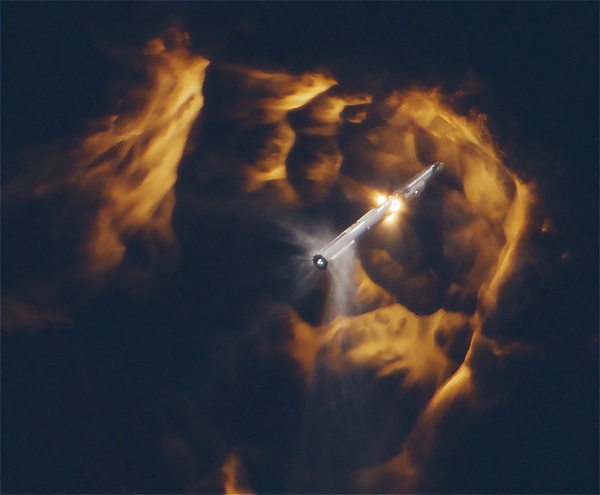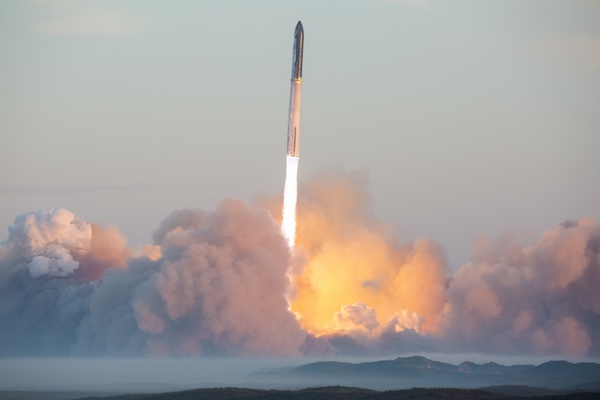Starship flies againby Jeff Foust
|
| What is clear that while SpaceX has made progress since that first flight, it’s less certain whether it’s moving swiftly enough both for the company and its biggest customer, NASA. |
One of the biggest signs of improvement was with Super Heavy. On the April launch, the booster suffered several failures of its Raptor engines, dooming the mission almost as soon as it lifted off the pad. SpaceX CEO Elon Musk said a couple months after that flight that the booster used a “hodgepodge” of older Raptors.
In a statement in September after the conclusion of a mishap investigation overseen by the FAA, SpaceX said that leaking propellant in the aft section of the booster created fires that severed connections with the primary flight computer. “This led to a loss of communications to the majority of booster engines and, ultimately, control of the vehicle.”
On this flight, by comparison, there were no apparently failures of the 33 Raptors in the Super Heavy booster. If there were any problems with those engines, they were not serious enough to affect the trajectory of the rocket.
A second major improvement was with the pad. The plume from those 33 Raptor engines tore up the concrete pad, sending debris up to ten kilometers from the pad, according to the US Fish and Wildlife Service (FWS). SpaceX acknowledged that it had underestimated the effects of the effects of the plume on the concrete without any kind of flame trench or deluge system based on static-fire tests at lower thrust levels that left the pad intact.
SpaceX installed a “steel sandwich” water deluge system at the repaired pad intended to prevent damage. That system, though, required an additional environmental review from FWS that held up the issuance of a revised launch license for the second launch. (The review concluded that the water from the deluge system “is expected to be less than an average summer rainfall event” and “would be unlikely to alter water quality.”)
That deluge system worked. Images of the pad showed no major damage after the launch. “Just inspected the Starship launch pad and it is in great condition!” Musk posted on X (formerly Twitter) on Sunday. “No refurbishment needed to the water-cooled steel plate for next launch.”
Other than the changes to the booster and pad to correct the problems seen in the first launch, the biggest change for Starship/Super Heavy’s second flight was a new stage separation system. Rather than a conventional approach of separating the stages and then igniting the upper stage engines—which never happened on the first flight because the vehicle failed before that point—SpaceX announced a change to a “hot staging” approach where the upper stage ignites its engines before separation. A new vented interstage section would allow the exhaust to escape during the few seconds between ignition and separation.
“This is the most risky thing, I think, for the next flight,” Musk said of the new stage separation approach in an online interview in June. The reason for doing so, he said, was to improve payload performance by avoiding losses from that brief coast during stage separation. “There’s a meaningful payload-to-orbit advantage with hot-staging that is conservatively about a 10% increase.”
| “There’s a meaningful payload-to-orbit advantage with hot-staging that is conservatively about a 10% increase,” Musk said in June. |
The staging itself appeared to work on flight two. The engines on Starship ignited and, a few seconds later, separated from the Super Heavy booster, a process that resulted in dramatic, almost ethereal images. Starship continued its ascent as Super Heavy started its return to Earth for a planned splashdown in the Gulf of Mexico.
However, about half a minute after separation, while performing a planned boostback maneuver, the booster suddenly broke apart, either on its own or after its flight termination system (FTS) was activated. SpaceX hasn’t provided additional information on the loss of Super Heavy, although the hosts of the SpaceX webcast stated that one thing they wanted to test on the flight was how the booster would handle the stresses from hot staging.
Starship continued its ascent, but about eight minutes after liftoff, not long before its engines were scheduled to shut down, SpaceX lost telemetry from the vehicle. It was traveling more than 24,000 kilometers per hour at an altitude of 148 kilometers at the time.
“We think we may have lost the second stage,” John Insprucker, principal integration engineer at SpaceX, said on the webcast. He later said that the FTS on Starship was triggered but didn’t indicate why it happened. SpaceX then ended the webcast and hasn’t provided an update on the test flight since then.
That meant that Starship didn’t complete the full flight profile, which like the first flight was to fly a “nearly orbital” trajectory that ended with a Starship reentry and splashdown in the Pacific Ocean near Hawaii 90 minutes after liftoff. However, the vehicle flew longer and achieved more milestones than the first flight, correctly the problems seen in the first one, while revealing new ones to be fixed.
Musk, in a post Sunday, said the booster and ship for the third launch “should be ready to fly in 3 to 4 weeks.” However, even if the vehicles and the pad are ready by then, the company will have to wait until it completes a mishap investigation and has it approved by the FAA. The updated launch license that SpaceX received from the FAA for the second flight was good for only a single flight, which means Starship can’t fly again until the FAA updates that license after the mishap investigation.
 The Starship upper stage separates from the Super Heavy booster using “hot staging” on the November 18 launch. (credit: SpaceX) |
NASA concerns
Starship, of course, is essential to SpaceX’s future, from the deployment of a new generation of larger, more powerful Starlink satellites to its long-term ambitions for human missions to Mars. Starship, though, is also critical to NASA, which is counting on the lunar lander variant of Starship to return humans to the lunar surface on Artemis 3 in the middle of the decade.
NASA officials have, in the months since Starship’s first flight, have shown some frustration with SpaceX’s pace of development of Starship for the Human Landing System (HLS) program.
“They have a significant number of launches to go, and that, of course, gives me concern about the December of 2025 date” for Artemis 3, said Jim Free, NASA associate administrator for exploration systems development, at a June meeting of two National Academies committees. He later mentioned the “difficulties” SpaceX was having with Starship that concerned him about the schedule for Artemis 3. “You can think about that slipping probably into ’26.”
Asked about those comments at a NASA press conference two months later, Free suggested NASA might change the plans for Artemis 3 if Starship was delayed. “We may end up flying a different mission if that’s the case,” he said. “If we have these big slips out, we’ve looked at if can we do other missions.”
He said then he had received an “updated schedule” from SpaceX about its Starship HLS work, but didn’t disclose it, saying NASA need “some time to digest it.”
| “Yes, the lander is absolutely important,” Free said of Starship HLS development for Artemis 3. “But, we also can’t go anywhere without the suits.” |
Two and a half months later, NASA was still digesting that schedule. “What I’m really happy about is that they’ve shown us that end-to-end focus,” Free said at the American Astronautical Society’s von Braun Space Exploration Symposium in Huntsville, Alabama, October 25. He did not disclose details about that schedule and how it affected planning for Artemis 3.
At both that symposium and a meeting Friday of the NASA Advisory Council’s human exploration and operations committee, Free appeared to dial back the pressure on SpaceX to come through on Artemis 3. “We have a whole bunch of new stuff that comes together for [Artemis] 3,” he said at the committee meeting, including not just the HLS version of Starship but also modifications to Orion to allow for docking and new spacesuits under development by Axiom Space.
“Yes, the lander is absolutely important,” Free said. “We can’t go anywhere without it. But, we also can’t go anywhere without the suits.”
Even a fully successful Starship test flight, though, would be only the beginning of SpaceX’s development efforts for a lunar lander. The company then needs to demonstrate cryogenic propellant transfer in orbit and the ability to launch Starships on a regular, rapid cadence to fill up a propellant tank in low Earth orbit that would then fuel the lunar lander Starship for its mission to the Moon.
At Friday’s committee meeting, Lakiesha Hawkins, assistant deputy associate administrator in NASA’s Moon to Mars Program Office, said the agency expected the total number of launches for each Starship HLS missions to be “in the high teens”, far higher than what SpaceX has previously stated. Musk, back in 2021, said he believed no more than eight launches of tanker Starships would be required, and could be as little as four.
Those launches, she said, would take place on a “six-day rotation” involving both the Starbase launch site at Boca Chica as well as a new Starship launch pad SpaceX is building at Kennedy Space Center’s Launch Complex 39A. While SpaceX has shown the ability to launch Falcon 9 rocket’s frequently—it carried out two such launches over the weekend just before and after the Starship launch—that cadence came after only many years of work by SpaceX. Artemis 3 is currently a little more than two years away.
Free, at the Huntsville conference, said he was looking ahead to the upcoming Starship test flight, sometimes designated OFT-2 for Orbital Flight Test 2. “We need OFT 2 to go, so I hope everybody in this room is cheering on OFT-2,” he said. “We need that to be successful to get us that much further down the road.”
But, like those debates from armchair analysts online after Saturday’s launch, he did not define what he considered it meant for the launch to be “successful.” In a social media post after the launch, he wrote, “Looking forward to seeing what can be learned from this test that moves us closer to the next milestone.”
Note: we are using a new commenting system, which may require you to create a new account.
